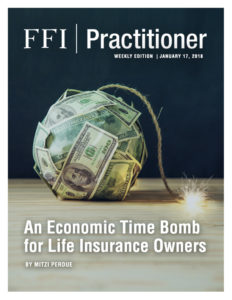
View this edition in our enhanced digital edition format with supporting visual insight and information.
Thanks to Mitzi Perdue for this week’s article addressing an international phenomenon impacting life insurance dividends and returns. Rather than putting life insurance policies in the proverbial “bottom left hand drawer,” her research recommends that, especially in a reduced interest rate environment, all of your client’s life insurance portfolios be evaluated to check and monitor their performance to avoid an “economic time bomb.”
Many of your clients may have a ticking economic time bomb in their portfolios, one that they are completely unaware of.
That’s the bad news. The good news for you as a family adviser is once you know that 23% of existing non-guaranteed life insurance policies are expiring prematurely, you can help your clients prevent or mitigate what can be a big problem.
The Life Insurance Your Clients Were Counting on May Not Be There
According to author and life insurance authority Henry Montag CFP, as many as 45% of life insurance policies are non-guaranteed policies. The life insurance premiums currently being paid may not be sufficient to keep the policies in force during the person’s normal life expectancy.
In Montag’s experience, 23% of all non-guaranteed life insurance policies right now are in danger of expiring prematurely. The individuals who bought the policies mistakenly believed that life insurance was a set-it-and-forget-it asset.
They were counting on these policies to cover estate taxes or long-term health care costs, or to leave their loved ones with an insurance estate. They, or their sons and daughters who are acting as amateur trustees, never knew they needed to monitor the policies’ premiums in the face of changing economic conditions.
What Could Go Wrong?
To see how this plays out in actual practice, let’s take the case of Peter Smith (not his real name). Twenty-five years ago, Smith purchased a $5 million policy. In Smith’s case, he was counting on it to pay his estate taxes so his son could continue the family business without being subject to income or capital gains taxes. Smith was also counting on the policy being in force until he was 90 years old.
However, as is likely to be the case with many of your clients, Smith acted as if life insurance was a “Buy & Hold” asset rather than a “Buy & Manage” asset. For tax reasons, he put the policy in an ILIT, an Irrevocable Life Insurance Trust, with his oldest son as trustee. Having done that, Smith barely even thought of his insurance policy for the next quarter century.
However, as happens with almost all family members who are amateur trustees, his son George was under the misimpression that he could simply place the insurance policy in a file drawer and forget it. Other than paying the annually-billed premium he received from the insurance company, a premium that had been determined 25 years earlier, Smith’s son simply neglected to pay any attention to its performance.
Further, George assumed that any important communications would be initiated by the broker and the insurance company. However, as often happens, the broker didn’t remain in touch with Smith once the initial transaction was completed.
According to John E. Schlifsky, Chairman and CEO of Northwestern Mutual, that’s likely to be the case with the majority of your clients as well. “Frequently neither the client nor the trustee has any relationship with the person who sold the policy to them.” Schlifsky then goes on to explain that since the broker’s compensation was almost entirely paid during the first year of the policy, the broker has minimal incentive to maintain a relationship. For most policy holders, there will be no further contact.
That’s not the end of the problem. In the case of Smith, and possibly in the case of your clients who own a life insurance portfolio, the broker didn’t point out any of the following highly relevant details:
- There’s no guarantee as to the duration of the coverage period. Smith thought he was buying a policy that would last until at least age 90. In fact, due to changing interest rates, his policy is due to expire when Smith reaches 83 next year.
- The policy would need active management with regard to changes in the amount of coverage, the premium cost, and the duration of the coverage period. The policy was not the set-it-and-forget-it asset that Smith assumed.
- Smith’s trustee would be taking on considerable legal liability for an area where he had no training or even awareness.
Trustees Have a Legal Liability
As Patricia Annino of Rimôn Law, author and nationally recognized authority on various aspects of estate planning, warns, “Often a client will select a trusted family member or a friend to serve as ‘Trustee’ of their insurance trust. However, since the friend or family member is serving as a favor and without compensation, frequently that family member or friend will pay little attention to the quality of the insurance company, the type of the insurance, or how it is performing.”
She emphasizes that, “This can lead to peril down the road because when someone agrees to be a Trustee, it does not matter if that person is a brother, grandmother, or a major financial institution, he or she has a fiduciary duty to the trust beneficiaries and can be held liable for any losses incurred to the trust assets.”
As Annino has seen, “With that legal role comes responsibility and liability. In an era of increased probate litigation, disgruntled beneficiaries are on the rise. When a client asks a family member or trustee to be a Trustee it needs to be understood that this is not a favor but rather a job with legal consequences, and the Trustee must comprehend that it is critical that attention is paid on an ongoing basis to the tasks at hand.”
Further, as Henry Montag points out in an American Bar Association Flagship book he recently co-authored, The Advisors’ and Trustees’ Guide to Managing Risk, “If the amateur trustee does not have the necessary knowledge nor skills needed to manage the ILIT, he or she is mandated to hire someone with the necessary skills to do the right job for the beneficiaries.”
A Chilling Discovery
For all the above reasons, when purchasing the policy, Smith and his trustee had some serious gaps in their knowledge of the insurance part of Smith’s portfolio. Actually, the gaps were more than serious. As we’ll see, these seemingly small gaps have upended Smith’s entire financial strategy.
Today, at age 82, Smith has just made a chilling discovery. He’s learned that without a 35% increase to his premium, his life insurance policy will no longer be in force when he turns 83.
When he bought the policy 25 years ago, interest rates were at 13%. Today they’re 2%. In this case, his insurance policy premium would need to be raised 35% to make up for the years of reduced earnings and the years of neglect when the premiums should have been raised.
Smith’s Unpleasant Choices–and Some of Your Clients’ as Well
At this point, Smith faces seriously unpleasant choices. He can let the policy expire next year, but if he does, he’ll lose all the premiums he’s paid over the last 25 years. Smith also realizes that unless he agrees to increase the premium required by the insurer, his children will not receive the life insurance legacy he allocated to them, nor will they benefit from the 25 years of premiums that he’s already paid.
Alternatively, he could pay tens of thousands of dollars in additional annual premiums to keep his particular policy active. In theory, that’s what he should do.
In practice, however he doesn’t have the cash flow to afford that. Nobody had ever warned him about the possibility of inadequate increased premiums; he didn’t prepare for this and to his dismay, he is unable to put his hands on the money he’d need to pay the increased premiums.
Because of the unexpected changes in interest rates and neglect on the part of the owners, many people are finding themselves in the same situation Peter Smith faces.
Montag estimates that as many as 45% of life insurance policies are non-guaranteed policies. The life insurance premiums currently being paid in many cases may not be sufficient to keep the policies in force during the person’s normal life expectancy.
In Montag’s experience, 23-25% of all non-guaranteed life insurance policies currently in force are in danger of expiring prematurely. Unfortunately, in many cases neither the insured/grantor, the beneficiaries, or their advisers are even aware that this problem exists.
Managing a Life Insurance Policy is the Insured’s Responsibility
Don’t expect either the insurer or the agent to manage the insured’s policy. Montag states that it is indeed possible that the insurer and insured’s economic interests may not always be aligned. In cases where the policy lapses, the insurer can retain the money already paid without ever having to pay out a death claim. It’s the sole job of the owner in the case of an individually-owned policy and the responsibility of the trustee in the case of a trust-owned life insurance policy.
As Montag recalls, “I would often see an individual with a six-figure stock or bond portfolio who would contact me twice a day or at least several times a month. Yet, that same individual with a multi-million dollar life insurance portfolio has not looked at nor reviewed his or her policy’s performance in years.”
Montag goes on to say, “90% of the owners of these policies are the children of the insured, and most often they don’t have the knowledge or the skills, or are they even aware that a life insurance policy is a Buy and Manage asset rather than a Buy and Hold asset.”
As family business advisers, help your clients avoid the Peter Smith scenario. Ask questions, and if necessary, alert them to the potential problem with their life insurance policy. You may need to direct them to seek accounting or legal advice as well as advice from an independent fee-based life insurance consultant. By being proactive, you may be able to save them from a world of unexpected financial pain.
 Mitzi Perdue is the author of How To Make Your Family Business Last: A Treasury of Checklists, Templates, Resources, and Tips. She is also a professional public speaker and businesswoman. Visit her website, www.MitziPerdue.com or e-mail her at mitzi@mitziperdue.com. She wishes to thank Henry Montag CFP, CLTC at henry@thetolicentereast.com, and www.thetolicentereast.com for his helpful advice on this article.
Mitzi Perdue is the author of How To Make Your Family Business Last: A Treasury of Checklists, Templates, Resources, and Tips. She is also a professional public speaker and businesswoman. Visit her website, www.MitziPerdue.com or e-mail her at mitzi@mitziperdue.com. She wishes to thank Henry Montag CFP, CLTC at henry@thetolicentereast.com, and www.thetolicentereast.com for his helpful advice on this article.

View this edition in our enhanced digital edition format with supporting visual insight and information.





